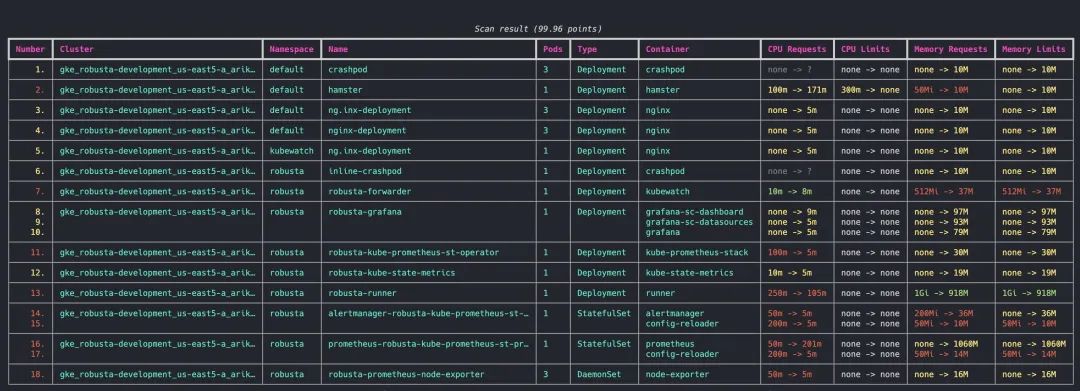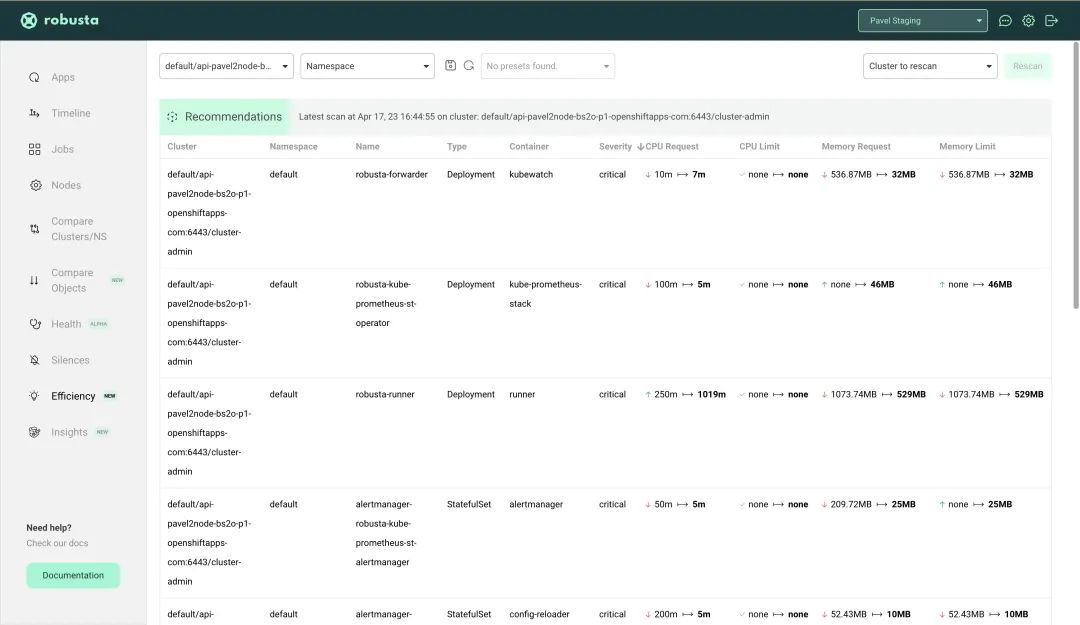
Robusta KRR(Kubernetes Resource Recommender)是一个用于优化 Kubernetes 集群中资源分配的命令行工具,它从 Prometheus 收集 pod 使用数据,并建议 CPU 和内存的 requests 和 limits 值,这可以大大降低成本并提高性能。

特征
- 无需代理:Robusta KRR 是一个在本地机器上运行的 CLI 工具,它不需要在你的集群中运行 Pods。
- Prometheus 集成:使用内置的 Prometheus 查询收集资源使用数据,自定义查询支持也即将推出。
- 可扩展策略:轻松创建和使用你自己的策略来计算资源推荐。
- 未来支持:即将推出的版本将支持自定义资源(例如 GPU)和自定义指标。
根据 Sysdig 最近的一项研究(https://sysdig.com/blog/millions-wasted-kubernetes/),平均而言,Kubernetes 集群有:
- 69%未使用的 CPU
- 18%未使用内存
通过使用 KRR 调整容器大小,你可以平均节省 69% 的云成本。
如果你使用 Robusta SaaS,从 v0.10.15 开始回集成 KRR,你可以查看所有建议(也包括以前的建议),按集群、命名空间或名称过滤和排序它们。

工作原理
指标收集
Robusta KRR 使用以下 Prometheus 查询来收集使用数据:
- CPU 使用:sum(irate(container_cpu_usage_seconds_total{{namespace="{object.namespace}", pod="{pod}", cnotallow="{object.container}"}}[{step}]))。
- 内存使用:sum(container_memory_working_set_bytes{job="kubelet", metrics_path="/metrics/cadvisor", image!="", namespace="{object.namespace}", pod="{pod}", cnotallow="{object.container}"})。
算法
默认情况下,KRR 使用一个简单的策略来计算资源推荐。它的计算方法如下(确切的数字可以在 CLI 参数中自定义):
- 对于 CPU,将请求设置为第 99 个百分位数,并且没有限制。这意味着,在 99%的情况下,您的 CPU 请求是足够的。对于剩余的 1%,我们没有设置限制。这意味着您的 Pod 可以突发并使用节点上可用的任何 CPU - 例如其他 Pod 请求但现在未使用的 CPU。
- 对于内存,使用过去一周内最大值并添加 5%缓冲区。
安装使用
MacOS/Linux 用户可以使用 brew 进行一键安装:
安装完成后可以执行下面的命令来检查是否安装成功:
如果想要手动进行安装,则首先确保在你的机器上安装了 Python 3.9 或以上版本。然后 Clone 代码:
安装依赖:
最后,运行下面的命令来运行工具:
请注意,使用源代码需要您作为 python 脚本运行,当使用 brew 安装时允许运行 krr。以上所有示例都将运行命令显示为 krr ...,如果您使用的是手动安装,请将其替换为 python krr.py ...。
安装完成后就可以来使用 KRR 工具了,比如可以运行一个简单的策略:
如果你只需要特定的命名空间(default 和 ingress-nginx):
默认情况下,krr 将在当前上下文中运行,如果你想在不同的上下文中运行它:
如果想获得 JSON 格式的输出(需要 --logtostderr,这样就不会将日志转到结果文件):
如果你想获得 YAML 格式的输出:
如果您想查看其他调试日志:
关于策略设置的更多信息,可以通过以下方式找到:
默认情况下,KRR 将尝试通过扫描下面的这些标签来自动发现正在运行的 Prometheus:
如果这些标签都没有找到 Prometheus,则将收到错误消息,那么就必须显式传递 url 了(使用 -p 标志)。
如果你的 prometheus 没有自动连接,我们可以使用 kubectl port-forward 手动转发 Prometheus。
例如有一个名为 kube-prometheus-st-prometheus-0 的 Prometheus Pod,则我们可以下面的命令对其进行端口转发:
然后,打开另一个终端并在其中运行 krr,给出一个显式的 prometheus url:
此外我们还可以根据自己的需求来创建自定义的策略,比如下面的代码就是创建一个自定义的策略:
GitHub 地址:https://github.com/robusta-dev/krr